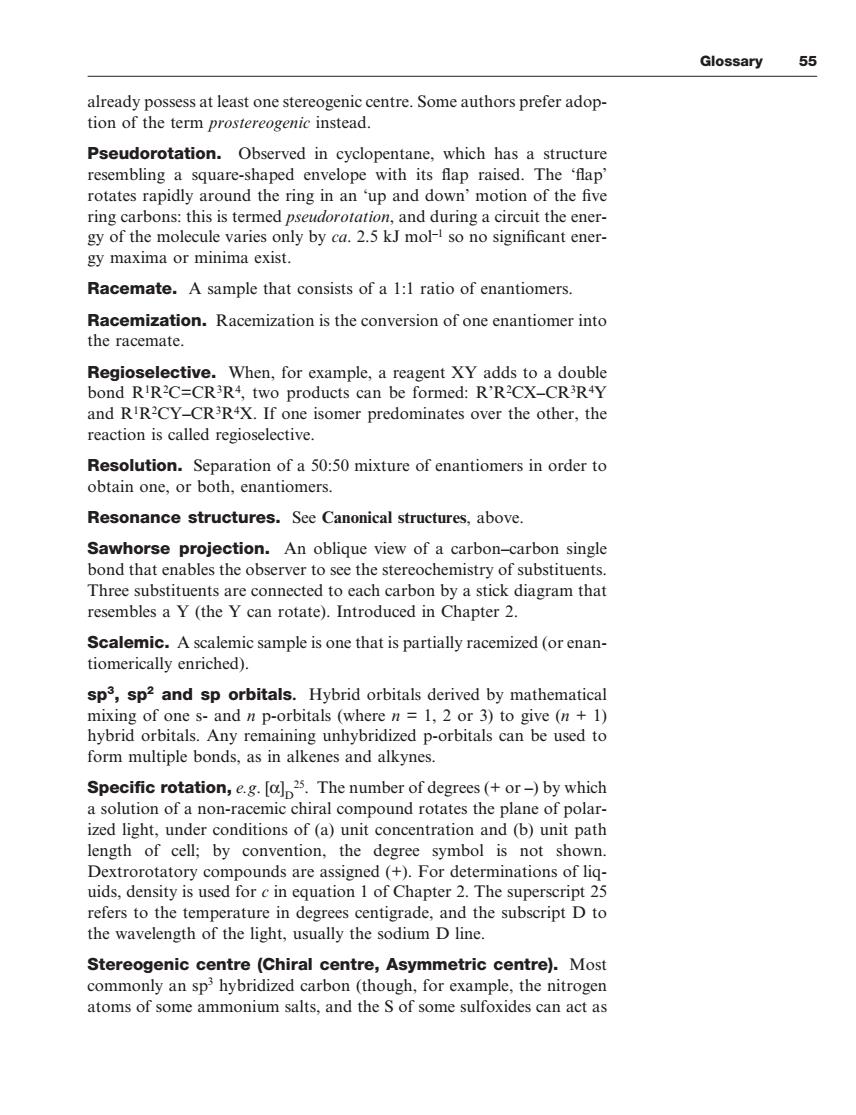正在加载图片...

Glossary 55 already possess at least one stereogenic centre.Some authors prefer adop- tion of the term prostereogenic instead. Pseudorotation.Observed in cyclopentane which has a structure resembling a square-shaped envelope with its flap raised.The 'flap rotates rapidly around the ring in an 'up and down'motion of the five ring carbons:this is termed pseudorotation,and during a circuit the ener- gy of the molecule varies only by ca.2.5 kJ mol-so no significant ener- gy maxima or minima exist. Racemate.a sample that consists of a 1:1 ratio of enantiomers Racemization.Racemization is the conversion of one enantiomer into the racemate. Regioselective.When,for example.a reagent XY adds to a double bond R'RC=CRR4,two products can be formed:R'R'CX-CRR+Y and RR2CY-CRRX.If one isomer predominates over the other,the reaction is called regioselective. Resolution.Separation of a 50:50 mixture of enantiomers in order to obtain one,or both,enantiomers. Resonance structures.See Canonical structures,above Sawhorse projection.An oblique view of a carbon-carbon single bond that enables the observer to see the stereochemistry of substituents. Three substituents are connected to each carbon by a stick diagram that resembles a Y(the Y can rotate).Introduced in Chapter 2. Scalemic.A scalemic sample is one that is partially racemized(or enan- tiomerically enriched). sp3,sp2 and sp orbitals.Hybrid orbitals derived by mathematical mixing of one s-and n p-orbitals (where n=1,2 or 3)to give (n 1) hybrid orbitals.Any remaini g unhybridized p-orbitals be used to form multiple bonds,as in alkenes and alkynes. Specific rotation,e.g.[ap25.The number of degrees(+or-)by which a solution of a non-racemic chiral compound rotates the plane of polar- ized light,under conditions of(a)unit concentration and(b)unit path length of cell;by convention,the degree symbol is not shown Dextrorotatory compounds are assigned (+)For determinations of liq- uids,density is used for c in equation 1 of Chapter 2.The superscript 25 refers to the temperature in degrees centigrade,and the subscript D to the wavelength of the light,usually the sodium D line. Stereogenic centre(Chiral centre,Asymmetric centre).Most commonly an sp'hybridized carbon (though,for example,the nitrogen atoms of some ammonium salts,and the S of some sulfoxides can act as already possess at least one stereogenic centre. Some authors prefer adoption of the term prostereogenic instead. Pseudorotation. Observed in cyclopentane, which has a structure resembling a square-shaped envelope with its flap raised. The ‘flap’ rotates rapidly around the ring in an ‘up and down’ motion of the five ring carbons: this is termed pseudorotation, and during a circuit the energy of the molecule varies only by ca. 2.5 kJ mol–1 so no significant energy maxima or minima exist. Racemate. A sample that consists of a 1:1 ratio of enantiomers. Racemization. Racemization is the conversion of one enantiomer into the racemate. Regioselective. When, for example, a reagent XY adds to a double bond R1 R2 C=CR3 R4 , two products can be formed: R’R2 CX–CR3 R4 Y and R1 R2 CY–CR3 R4 X. If one isomer predominates over the other, the reaction is called regioselective. Resolution. Separation of a 50:50 mixture of enantiomers in order to obtain one, or both, enantiomers. Resonance structures. See Canonical structures, above. Sawhorse projection. An oblique view of a carbon–carbon single bond that enables the observer to see the stereochemistry of substituents. Three substituents are connected to each carbon by a stick diagram that resembles a Y (the Y can rotate). Introduced in Chapter 2. Scalemic. A scalemic sample is one that is partially racemized (or enantiomerically enriched). sp3, sp2 and sp orbitals. Hybrid orbitals derived by mathematical mixing of one s- and n p-orbitals (where n = 1, 2 or 3) to give (n + 1) hybrid orbitals. Any remaining unhybridized p-orbitals can be used to form multiple bonds, as in alkenes and alkynes. Specific rotation, e.g. [α] D 25. The number of degrees (+ or –) by which a solution of a non-racemic chiral compound rotates the plane of polarized light, under conditions of (a) unit concentration and (b) unit path length of cell; by convention, the degree symbol is not shown. Dextrorotatory compounds are assigned (+). For determinations of liquids, density is used for c in equation 1 of Chapter 2. The superscript 25 refers to the temperature in degrees centigrade, and the subscript D to the wavelength of the light, usually the sodium D line. Stereogenic centre (Chiral centre, Asymmetric centre). Most commonly an sp3 hybridized carbon (though, for example, the nitrogen atoms of some ammonium salts, and the S of some sulfoxides can act as Glossary 55